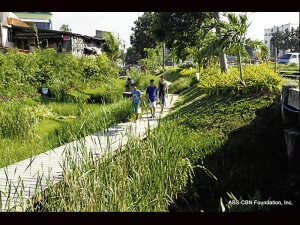
COMMUNITY Gardens are green spaces in urban neighborhoods that have been transformed from idle vacant lots into colorful and vibrant crowd-pleasing gardens where community dwellers converge. PHOTO BY ABS-CBN Foundation Inc.
There is much to say about most mega cities. The same is true about Metro Manila. People complain about traffic, pollution, oversized and indecent billboards, inefficient and gaudy street lights, narrow and inexistent sidewalks as well as the lack of street signs.
Many people make suggestions on how to beautify the place. One aspect with considerable impact could be the introduction of community gardens in Metro Manila.
What are community gardens? These are green spaces in urban neighborhoods that have been transformed from idle vacant lots to colorful and vibrant eye-pleasing gardens where community dwellers converge.
Today thousands of community gardens in the United States have already been put up and have shown that they have improved quality of life.
Research shows that community gardens have resulted in neighborhood stabilization. This has brought about an increase in the number of owner-occupied dwellings, and good rental income in areas surrounding community gardens.
It is also reported that economic activity improved in the area. This is the result of a positive outlook generated by a healthy and pleasant environment.
Other benefits
Community gardens is one of the most effective ways to counter the negative impact of urbanization in Metro Manila.
Urbanization results in the loss of open and green spaces giving way to a concreted built environment. One significant effect is the drop of the quality of water in the city because of the increase in sedimentation that is washed away into the water system. This is the reason for the growing concern for surface water management and good water drainage systems.
Rain falling on any land development should be able to go back to the environment to recharge aquifers and natural waterways without deterioration to the quality and quantity as much as possible. This is the mantra for sustainable design as far as water is concerned.
Community gardens help to conserve water by capturing stormwater runoff.
Stormwater runoff is water from rain or other sources that flows over the land surface, and is a major component of the water cycle.
Previously we channeled rainwater from the roof and hard or impervious surfaces into sewerage and drain pipes. Now we are encouraged to catch rainwater in pervious or porous paving systems or better yet—community gardens. This will naturally recharge the aquifer or ground water.
Excellent example
A very good project where community gardens are revitalizing parts of Manila is now being developed by Gina Lopez who heads the commission for rehabilitating the Pasig River.
Tasked to clean up the river, her strategy is both ambitious and challenging—to clean Pasig River by cleaning the tributaries or esteros first. The question remains: how do you clean the esteros?
There is one clear strategy—to build green communities with low-rise green buildings and community gardens. Ms Lopez’s goal is also to retain many of the existing dwellers in the area instead of transporting them to some distant area away from the city.
The project’s “river warriors,” made up of local residents whose task is to monitor the development in the area, are the first beneficiaries of the proposed green housing projects.
A very optimistic Gina Lopez explained that the project is bringing not only green communities to an otherwise neglected sector of Metro Manila but also hope to the residents who will now have a chance to be active contributors to our society.
The commission is working in close collaboration with the Green Architecture Movement of the United Architects of the Philippines headed by President Ramon Mendoza.
For comments or inquiries, e-mail amadodejesus@ gmail.com.

